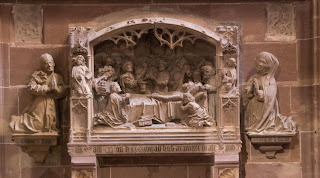Today Strasbourg is the home to the European Parliament and
a huge student population. Nevertheless it is a charming city with a small town
feel. Over the last century it has changed from French to German at least four
times so one gets strong German and French influences on this capital of the
Alsace. It’s location just off the Rhine on a smaller tributary for defense
purposes means one can even take a canal boat tour of the city. We did not do
this but even on a cold day in December people were lined up for the tour.
The highlight of any visit to Strasbourg is the magnificent
cathedral. One is first struck by the delicacy of this huge building. Gothic
use of flying buttresses changed the look of cathedrals from the ponderousness
of the Norman architecture to a lighter and loftier look inside and out. The use
of the buttresses meant that the support columns could be smaller and the
building itself could be wider and taller. The Strasbourg Cathedral, completed
in 1439 is a magnificent example of the Gothic style.
Inside, one is immediately overwhelmed by the stained glass.
Every bit of light that enters the building enters through one of the stained
glass windows. While almost every cathedral has some stained glass, Strasbourg
is one of the very few with no clear windows at all. It is interesting that
some of them are painted and then fired in a kiln while the glass in other
windows was created by adding minerals directly to the glass as it was
manufactured. You have to look closely to see the difference and I don’t notice
it unless it is pointed out.
The other highlight of this cathedral is the astronomical
clock. This is the third clock built on the site, the first two being built in
the 14th and 16th centuries. The current one was
completed in 1843 after five years of labor by 30 workers. Besides the actual
clock, it includes a perpetual calendar, a planetary and a display of the sun
and moon in their real position including eclipses. At 12:30 each day a
life-size cock crows three times and 18-inch figures of Jesus and the Apostles
parade around the façade. We missed seeing the procession as the line was
already too long by the time our tour of the city ended.
The sculpture work on cathedrals is always interesting, especially the gargoyles.
For Christmas we also got to view a 100-foot long Nativity
scene that filled one side of the left nave.
We had a very nice lunch at one of the old restaurants in
town before wandering the Christmas markets and taking the bus back to our
ship.
 |
| Flowers in memory of the Paris shootings |
For me an added highlight was watching the construction of a
new bridge across the Rhine. We were delayed about four hours by the work. The
bridge will consist of two spans each of which was constructed on shore and
then had to be maneuvered into place. They were placing the first of the two
spans on the day we were there. Of course the job took longer than expected so
we had to wait while they finished. The span was already on a barge, but
supported only in two places so maneuvering it had to be done with great care.
I watched for about two hours as it would move a bit and then stop for a while.
The bridge just upstream offered a great view of the progress although it was
impossible to see exactly why they kept stopping. I had to leave before they
were able to place the span on its new piers which was disappointing, but the whole
process was interesting nevertheless.
Portland is using an interesting technique to replace a
bridge over the Willamette River. Since this is a replacement and the
approaches are limited, the engineers decided to build a set of temporary piers
next to the old bridge and then slide the old bridge onto those temporary
piers. That way they could build the new one completely in place without
disrupting traffic too much. It took them three days to slide the old bridge
onto those temporary piers at a speed measured in inches per hour. The new Sellwood Bridge is now in place.
























No comments:
Post a Comment